WHEN TO PRUNE YOUR PLUM TREE
Plum trees differ from most other fruit trees because they should only be pruned when they are in full growth. In the UK, the best time to prune your plum tree is in, mid June 2017 , never in winter when they are dormant. The reason is that pruning your plum tree when it is dormant will expose it to the risk of Silver Leaf disease and other fungal infections.
Strongly growing plum trees are more resistant fungal infections. It's also the case that Silver Leaf Disease spreads through spores which are far more common in the damp conditions which exist in autumn and winter.
In general any time from late spring to the end of July is the risk free time to prune your plum tree.
There are two exceptions to this rule (there is always an exception or two!) and they are:
- A newly bought one year old plum tree planted in winter. The supplier of a new plum tree should
have identified if they have sold you a one or a two year old plum tree. If not see the two
diagrams lower down this article to help you identify what age your tree is.
It is important to prune a one year plum tree as soon as possible to help it establish a good structure. At the same time, pruning in winter exposes the tree to fungal infections. With these two factors in mind we recommend pruning a one year old tree in early March (late March in cold areas of the UK).
Prune on a dry day and use a sharp pair of secateurs. Make the cut a sloping one to avoid water settling on the cut surface. See pruning a one year tree below for more details.
- Where an established plum tree suffers breakages of one or more branches (wind and weight of
fruit are two common reasons) then it is best to prune back the broken branch to good solid wood
immediately. The tree will suffer less if a branch has been cleanly cut compared to a breakage
where the surface of the broken branch is open and ragged.
Prune on a dry day and use sharp secateurs / pruning knives.
HOW TO PRUNE YOUR PLUM TREE
Many books and website articles over-complicate the task of pruning plum trees but in truth they are far more tolerant of incorrect pruning compared to apple and pear trees. The basic principles to adhere to are to prune once a year at the time given above and to prune them to a wine goblet shape with the centre of the tree relatively free from branches and foliage.
The "wine goblet" principle of pruning encourages the branches to grow up and away from the centre of the tree. The majority of shoots growing into the centre of the tree are pruned away completely and those growing outwards are hard pruned to encourage more growth this and next year.
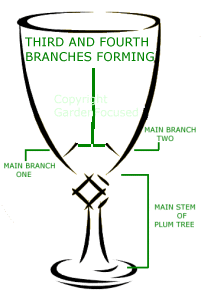
The picture above is our graphically challenged attempt at explaining the idea behind pruning a plum tree to a wine goblet shape. In an ideal world your plum tree should end up with three or four main branches growing from the main trunk of the tree.
The diagram shows only two of the main branches coming from the main stem although if you are lucky you might manage all three or four coming from the main stem. In many cases though, only two main branches will come at the correct height. Another main branch should then be left to grow from the original two branches (see branches 3 and 4 in diagram)
It will be impossible to get it exactly accurate, but however many main branches you choose to have, they should be roughly evenly spaced out to give the tree balance.
If you prune your plum tree at the correct time of year (see section above) you will be pruning your plum tree when the fruit has already started to form. This will lead you into the temptation of under-pruning it to avoid cutting off fruit bearing shoots and stems. Avoid the temptation and prune the tree correctly!
Most plum trees form far too much fruit and this can be severe enough to cause the branches to break under the weight, Victoria plum trees are a prime example of this. Correct pruning will indeed remove a few potentially fruit bearing stems but this will only improve the health of the tree and result in larger plums.
One particular plum tree we have reviewed, Cambridge Gage, is slow to establish and we recommend less pruning than recommended below. See the Cambridge Gage tree page here for specific details on pruning this variety.
Pruning in the first and second year of a plum tree's life is easier but slightly different because there are fewer branches to prune. The three diagrams below explain how to prune a plum tree in years one, two and three.
HOW TO PRUNE A ONE YEAR OLD PLUM TREE
Read the above section entitled "How to Prune Your Plum Tree" above carefully before starting year one pruning. It will help explain the overall process and aims of pruning your plum tree.

First year pruning is very easy, simply prune back the stem to about 1m / 3ft high in early to late March (see below for why at this time of year). If you are intending to grow your plum tree as a half-standard bush then prune to 1.2m / 4ft or 1.6m / 5ft for a full standard.
You want at least two branches to form from the main stem and these will come from buds clearly visible. So in year one you may want to prune the main stem slightly higher so that a promising bud or two, in the correct position, is left on the main stem.
It is important to prune a one year plum tree as soon as possible to help it establish a good structure. At the same time, pruning in winter exposes the tree to fungal infections. With these two conflicting factors in mind we recommend pruning a one year old tree in mid March (late March in cold areas of the UK).
The supplier of your plum tree will have told you the age of your plum tree when you bought it. If you don't know the age of your tree use the diagram above and below to decide if your new tree is one or two years old.
Prune on a dry day and use a sharp pair of secateurs. Make the cut a sloping one to avoid water settling on the cut surface. Current advice is not to use a pruning sealant on the cut.
So we can get the timings correct for year two and three pruning, let's assume you plant your new,
one year old tree in January 2017 and pruned it for the first time in March 2017. Dates below will be based on this date.
HOW TO PRUNE A TWO YEAR OLD PLUM TREE
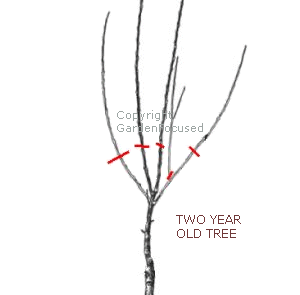
This section on pruning a two year old plum tree applies to the following two situations:
- You bought a one year tree in January 2017 and pruned it shortly afterwards in March 2017 (see first year pruning above).
This second year pruning should occur in
mid June 2018.
- You bought and planted a two year old tree in winter (example date January 2017) and wish to prune it for the first time in mid June 2018.
Prune back the main branches to a length of about 30cm / 12in. Prune back any side shoots to a length of 15cm / 6in. Prune weak shoots away completely and trim back any stems which are crossing. Prune on a dry day and use a sharp pair of secateurs. Make the cut a sloping one to avoid water settling on the cut surface.
During the pruning cut the shoots and branches to an outward facing bud to try and achieve the goblet shape with a clutter free central part. If the position of an outward facing bud only occurs further down the stem to be pruned, prune to that point.
HOW TO PRUNE A THREE YEAR OLD PLUM TREE
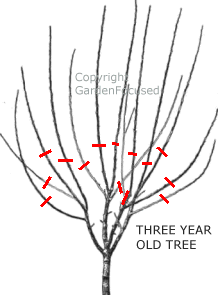
Using the example dates given in the above two sections this pruning will occur in
mid June 2019.
Third year pruning is the same as second year pruning. Prune back the branches to a length of about 35cm / 14in. Prune back any side shoots to a length of 15cm / 6in. Prune weak shoots away completely and trim back any stems which are crossing. Prune on a dry day and use a sharp pair of secateurs. Make the cut a sloping one to avoid water settling on the cut surface.
Cut the shoots and branches to an outward facing bud to try and achieve the goblet shape with a clutter free central part. If the position of an outward facing bud only occurs further down the stem to be pruned, prune to that point. Particular attention should be paid to keeping most of the centre of the plum tree free from branches. This helps the overall health of the tree by allowing free air circulation thus avoiding fungal diseases.
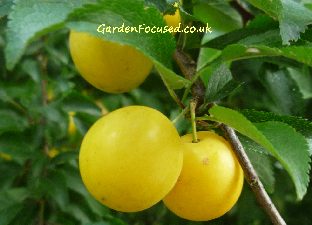
Yellow Mirabelle Plums
PRUNING IN LATER YEARS
Prune the top stems and branches by about a third to keep the plum tree from growing too high. Other stems and branches should be trimmed to maintain an overall goblet shape. Once again, prune away shoots growing into the centre of the tree to keep it relatively open.
PRUNING LARGER NEGLECTED PLUM TREES
Many plum trees are inherited when properties are bought and you may find that they are an overgrown, over-tall tangled mess. Fear not! We have written a web page which shows you exactly how to set about pruning such plum trees to reduce the height, open up the centre of the tree and bring down the level of fruit production so they can be picked without a triple extension ladder. Click here to go to that page now.
DO I PRUNE FRUIT BEARING BRANCHES?
Because the best time to prune a plum tree is in the summer many gardeners are concerned that they will need to prune away branches which are bearing fruit. In the majority of cases though this is not really a concern. In years one to three the above recommendations do show significant pruning in order to establish a good basic shape for the future but very few plum trees will produce fruit in their first three years of life so almost no fruit will be pruned away.
In later years we recommend pruning the top growing stems to keep the height within bounds – these top stems will not be bearing fruit, the fruit will be lower down. Some pruning of the lower shoots is recommended to keep the centre of the tree open and if those inward growing stems are bearing fruit then a small number of fruits will indeed be pruned away. However, plum trees do produce lots of fruit and the crop will still be large.
CAN PLUM TREES BE PRUNED TO A CORDON SHAPE?
In theory plum trees can be pruned to a cordon shape but in practical terms it’s not advisable. To create a cordon shaped fruit tree you need to prune several times a year and also at several points on the stem. Unfortunately plum trees don’t respond well to frequent pruning because it significantly increases the risk of introducing infections. This is probably the key reason why you very rarely see cordon plum trees.
FINAL THOUGHTS ON PRUNING PLUM TREES
Don’t be panicked by the idea of pruning your plum tree, they are far more tolerant of bad pruning compared to apple or pear trees. Keep the height within bounds, prune away weak shoots, keep the centre reasonably clear and you won’t go far wrong.
The tree above is not ideally formed, it has a bias to one side which makes it slightly unbalanced. But nature has bulked out the correct branches to make sure the tree remains relatively stable. And the proof of the pudding is in the eating, this plum tree produces lots of delicious fruit year after year!
HOW TO CARE FOR PLUM TREES
Plum trees require very little care throughout their life (aside from a yearly pruning) but will produce of their best if you thin the fruit, mulch the surrounding ground and give them an annual feed. These are all described in detail below.
THINNING PLUM FRUITS
Plum trees are well known for producing vast amounts of plums in some years. This is not good for you for two reasons. First, if too many plums are produced, each individual fruit will be small and may well not ripen fully. The second problem with over-production of fruit is that the sheer weight of the fruit can cause branches to break and they don’t break cleanly in most cases.
This will ruin the structure of the tree and often leave jagged open wounds which are a source of fungal diseases. Brown Rot is often caused by trees bearing too much fruit which has not been thinned.
Judging how much fruit should be left on your plum tree is really a matter of experience gained over a couple of years, every tree is different. But as a general rule thin young fruits so that at maturity 3cm / 1in will be left between each fruit. The best time to thin plum tree fruit in your area is
One useful tip when thinning plum fruits is to remove more of the fruit which receives less sunshine. In practice, fruits which are nearer the centre of the tree and those which are on the shady side of the tree will ripen slower and should be thinned in preference to those which are likely to receive the most sunshine. Don’t go overboard with this principle but bear it in mind.
MULCHING PLUM TREES
Plum trees require a constant source of moisture at their roots especially when the fruits are forming. A mulch with any organic matter around the base of tree each spring will go a long to providing these conditions. If you have no organic material to hand then think again, a mulch of grass cuttings will do the job very well. If you have the money a bag of chipped bark will provide a long-lasting mulch.
ANNUAL FEED
A long lasting organic feed such as blood, fish and bone (three handfuls per tree) will provide them with an excellent tonic. It is best applied in spring just before you spread mulch around the trees.
COMMENTS / QUESTIONS LEFT BY OUR READERS
We have moved the Plum Tree comments and questions section to its own page which can be visited by clicking here. On that page you can view all the previously asked questions / answers / comments and also ask any new questions of your own.
The questions and answers page contains a large amount of additional information about plum tree problems.
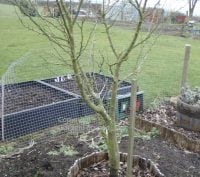

Rootstocks and Size
Pests and Disease
Guide to Planting
Pollination Groups
Care Plan and Pruning
Pruning Older Plum Trees
Top Ten Plum Tree Varieties
Plum Tree Questions and Answers
HOW TO PRUNE A PLUM TREE
By David Marks
Looking after a plum tree is principally a once a year task of pruning it. If pruning is done correctly, and it’s not complicated, then they are unlikely to suffer from many problems.
There are three forms of plum tree, the most common is the bush form, the less common are pyramid and standard forms.
Occasionally people grow plum trees in a fan form against a wall.
This article deals with pruning a bush shaped plum tree, by far the most common. It answers the common questions of when to prune, how to prune and also explains how to tackle older more overgrown plum trees.